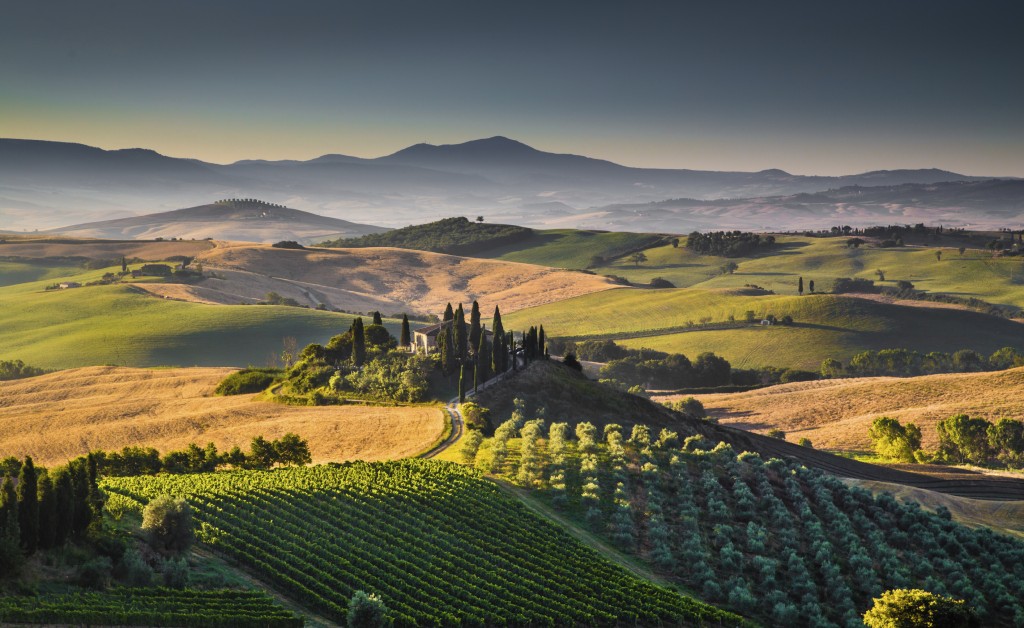Wines known as being wines of Tuscany are made from grapes cultivated along the Tyrrhenian coast of Italy. That means that the names of these wines are some of the most well known throughout the world, and include Chianti, Brunello (technically Brunello di Montalcino) and Montepulciano (technically called Vino Nobile di Montepulciano).
Interestingly enough, all three of these wines are crafted from the Sangiovese grapes, which have been grown in Tuscany for so long that they date to the Estruscan era. The vines of most vineyards are so old that the growers have actually hybridized and cloned them to such an extent that some towns and provinces now have their own, unique forms of Sangiovese grapes.
This is why travelers can so easily become confused. For example, you may have booked a stay in an Isle Blue villa in Tuscany, arranged for a car or driver, and planned a vineyard tour. You may visit one location and hear about a “brunello” in a glass of Montalcino or a “prugnolo” in a bottle of Montepulciano. Fear not, however, as both are actually taken from the famous Sangiovese and will still have the distinct aroma and flavor.
What are the differences between the wines if they are all made of similar grapes? Geographically, the vines are grown in different areas. They even take their direct names from the villages near which the varieties are grown. As the simplest example, the Brunello di Montalcino wines are made from a Sangiovese variety that originates near the village of Montalcino.
The chianti are towards the north, while the other varieties are typically towards the south. Additionally, the altitudes are different between the vines. Montepulciano and Montalcino vines are usually at lower and warmer spots while the chianti vines are higher and cooler.
Generally, the chianti wines are aged for shorter periods than the other varieties. For example, some chiantis are bottled and sold within two years, while a Montalcino might have to age for five before it is sold. However, aging also changes based on the growing season.
Chianti is produced in the highest quantities, with estimates putting this variety at over eight million cases annually.
A wonderful way to best understand the three Tuscan wines is to plan a tour of the vineyards while on a holiday in the region. Stretching from Florence to Siena, this “wine route” is dotted with large and small establishments, and one thing any traveler should note is that more and more growers are going organic, greener, and using old-fashioned methods to reintroduce the better flavors and results.
Some of the best places to pay a visit, do a tasting and learn about the different varieties include:
Val delle Corti in the Chianti region
Villa Pomona at Castellina in the Chianti region
Fontodi is a larger winery also in the Chianti area, and set beneath the village of Panzano it is an organic farm that uses terracotta rather than wooden barrels
Le Boncie is in the San Felice area and offers chianti wines made in smaller batches
Salcheto is a self-sufficient winery that is located above the town of Montelpuciano and described as one of the best in the region
Biondi Santi – Tenuta il Greppo is in the Montalcino area and one of the most famous for its Brunello
Castiglion del Bosco is within the Orcia valle, a UNESCO World HeritageSite and known for its Brunello
Naturally, one of the best ways to educate your palate to the differences between Brunello, Chianti and Montepulciano is to head right to the source. A visit to Tuscany is the ideal time to make a tour of the best vineyards, sampling their latest bottles, and even enjoying a meal in some of the many restaurants that serve the vintages.
Comments
comments
